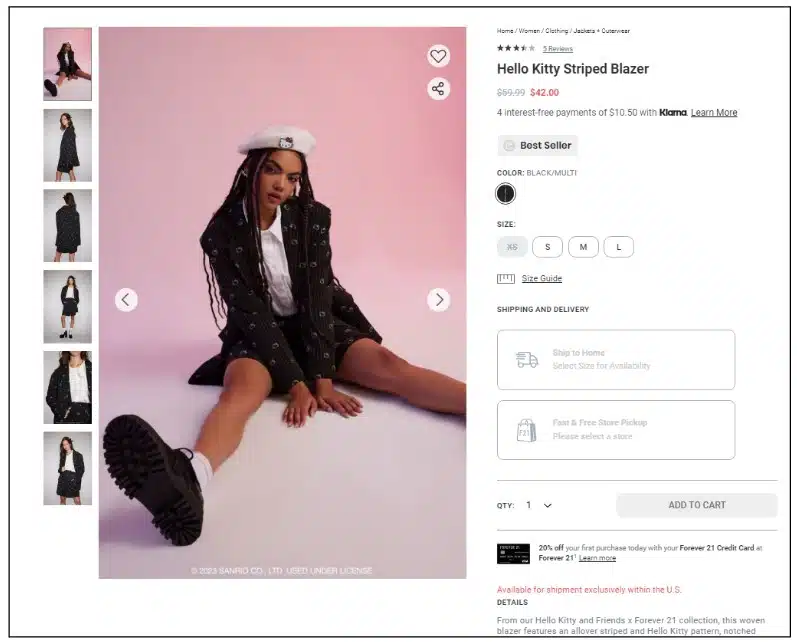In the world of ecommerce, a product detail page (PDP) is a crucial component that can make or break a sale. A PDP in ecommerce is the web page that provides comprehensive information about a specific product, including its features, specifications, pricing, and customer reviews. It serves as the digital equivalent of a product’s packaging, enticing potential customers to learn more and ultimately make a purchase. In this article, we’ll dive into the essence of PDPs and explore the key elements that constitute a highly effective product detail page.
A product detail page on Forever 21
Importance of a Product Detail Page (PDP)
PDPs play a pivotal role in the customer’s journey through an ecommerce website. When a potential buyer lands on a PDP, they expect to find all the relevant information they need to make an informed decision. A well-crafted product detail page not only showcases the product’s features and benefits but also instills confidence in the buyer, increasing the likelihood of a successful conversion.
Moreover, PDPs contribute to search engine optimization (SEO) efforts. Search engines like Google index individual product pages, making them discoverable through relevant search queries. By optimizing PDPs with targeted keywords, meta descriptions, and structured data, ecommerce businesses can improve their visibility in search results and attract organic traffic.
Key Elements of a High-Converting Product Detail Page
To create a PDP that effectively engages and converts visitors, several essential elements must be considered:
- Product Title: Craft a clear, concise, and informative product title that accurately describes the item and includes relevant keywords. A well-written product title helps customers quickly understand what the product is and improves search engine visibility.
- Product Image: High-quality product images are the cornerstone of a compelling PDP. Provide multiple angles, zoom functionality, and the ability to view the product in different colors or variations. Visual content helps customers visualize the product and reduces the perceived risk associated with online purchases.
- Product Description: Craft a comprehensive and engaging product description that highlights the key features, benefits, and unique selling points of the product. Use persuasive copywriting techniques to evoke emotions and address potential objections. Include technical specifications, dimensions, and any other relevant details that help customers make an informed decision.
- Clear Pricing and Availability: Display the product’s price prominently, along with any discounts, promotions, or bundle offers. Provide information about the product’s availability, estimated shipping times, and any associated costs. Transparency in pricing and availability reduces friction in the buying process.
- Customer Reviews and Ratings: Social proof is a powerful influencer in ecommerce. Incorporate customer reviews and ratings on the PDP to build trust and credibility. Positive reviews from satisfied customers can alleviate doubts and encourage hesitant buyers to proceed with their purchase.
- Shipping Information: Include clear and detailed shipping information on the PDP. Specify the available shipping options, estimated delivery times, and any associated shipping costs. Provide information about international shipping, if applicable, and any potential customs or import fees.
- Return Policy: Clearly communicate the return and refund policy on the PDP. Explain the process for initiating a return, the timeframe within which returns are accepted, and any associated restocking fees or shipping costs. A transparent and customer-friendly return policy can boost customer confidence and encourage purchases.
- Product FAQ: Anticipate common questions customers may have about the product and include a frequently asked questions (FAQ) section on the PDP. Address concerns related to sizing, compatibility, installation, maintenance, or any other product-specific queries. A comprehensive FAQ section can reduce customer support inquiries and provide additional reassurance to potential buyers.
- Call-to-Action (CTA) Buttons: Place prominent and visually appealing CTA buttons, such as “Add to Cart” or “Buy Now,” to guide customers towards the next step in the purchase journey. Ensure that CTAs are easily accessible and strategically positioned to maximize conversions.
- Related Products and Upselling Opportunities: Incorporate sections for related products, frequently bought together items, or product recommendations based on the customer’s browsing history. Cross-selling and upselling techniques can increase average order value and encourage customers to explore additional offerings.
- Mobile Optimization: With the growing prevalence of mobile commerce, it’s crucial to ensure that PDPs are optimized for mobile devices. Responsive design, fast loading times, and touch-friendly navigation are essential for providing a seamless mobile browsing experience.
Best Practices for Product Detail Page Optimization
To continually improve the performance of PDPs, ecommerce businesses should adopt the following best practices:
- A/B Testing: Conduct A/B tests on various elements of the PDP, such as product descriptions, images, CTAs, and layouts. Analyze the impact on conversion rates and user engagement to identify the most effective variations.
- User Experience (UX) Enhancements: Continuously refine the UX of PDPs based on user feedback and behavioral data. Streamline the navigation, improve the product information architecture, and optimize the checkout process to minimize friction and abandonment.
- Personalization: Leverage personalization techniques to tailor PDPs to individual customers. Use data-driven insights to showcase relevant product recommendations, personalized offers, and targeted content based on the customer’s preferences and browsing history.
- Performance Optimization: Ensure that PDPs load quickly and efficiently across all devices and network conditions. Optimize images, minimize HTTP requests, and leverage caching techniques to enhance page load times and improve user satisfaction.
- Customer Feedback Integration: Actively seek and incorporate customer feedback to continuously enhance PDPs. Analyze customer reviews, support inquiries, and user surveys to identify areas for improvement and address common pain points.
Wrap up:
Product detail pages are the linchpin of ecommerce success. By crafting compelling and informative PDPs, businesses can captivate potential customers, build trust, and drive conversions. By focusing on key elements such as product imagery, detailed descriptions, customer reviews, and clear CTAs, ecommerce brands can create PDPs that effectively showcase their products and persuade visitors to make a purchase.
However, optimizing PDPs is an ongoing process that requires continuous refinement and adaptation to evolving customer expectations and market trends. By staying attuned to PDP best practices, conducting regular testing, and prioritizing user experience, ecommerce businesses can unlock the full potential of their PDPs and gain a competitive edge in the digital marketplace.
Frequently Asked Questions:
A PDP is a web page that provides comprehensive product information, including features, pricing, specifications, and customer reviews, to help customers make informed purchasing decisions.
PDPs are crucial because they build customer trust, provide detailed product information, and enhance conversion rates. They also improve SEO, making products more discoverable via search engines.
Key elements include a clear product title, high-quality images, an engaging description, transparent pricing, customer reviews, clear CTAs, and comprehensive shipping and return policies.


